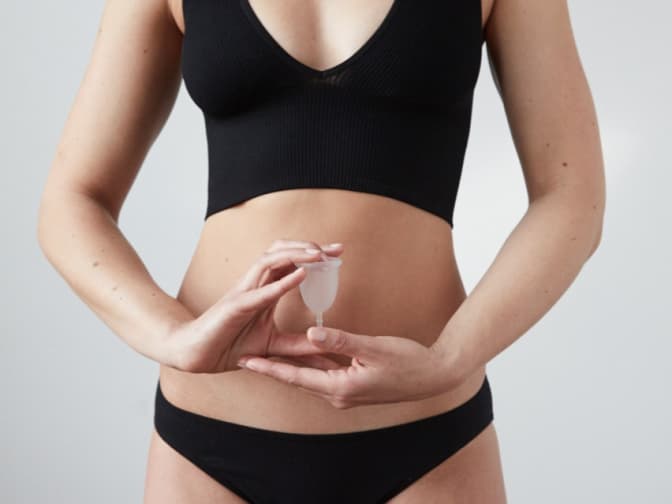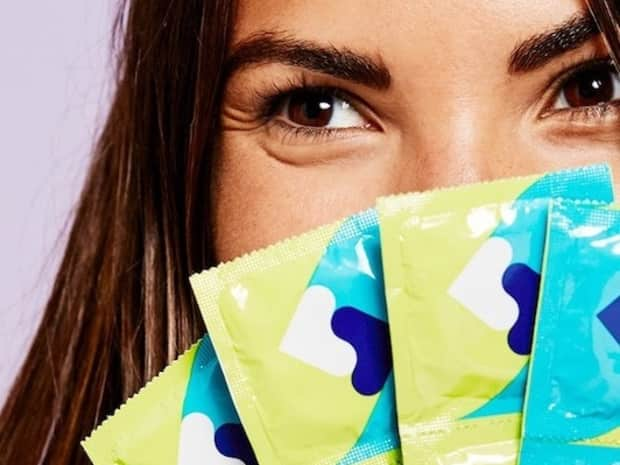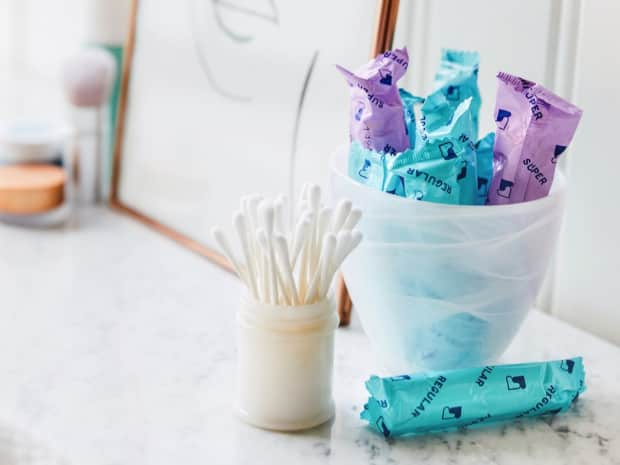
Eco-friendly
“Period cups are the most sustainable option when it comes to period care,” says Hollender. “One period cup, on average, replaces 720 tampons that will end up in a landfill. That’s huge.”


Last Updated: June 11, 2021
Whether they're called menstrual cups or period cups, these environmentally friendly and cost-effective feminine care items might just be your next sustainable swap.
Menstrual (or period) cups ... you may have friends that swear by them or have just heard about them in passing, but they’re more than just environmentally friendly — they save you money and save your vagina from discomfort sometimes caused by traditional period care products. But we understand the idea of making the switch to period cups can be daunting or downright confusing.
“The biggest misconception about period cups is that you’ll leak if you use one because people have a hard time believing that a cup the size of a shot glass(!) could hold up to six hours of menstrual fluid,” says Meika Hollender, co-founder and president of Sustain, which offers menstrual cups in two sizes. “But we bleed a lot less than we think we do! Most people who try cups say how surprised they are by how little they bleed.”
Ready to make the switch? Just like when you started using traditional or organic tampons, cup insertion can take a little practice at first. Here’s an easy and helpful primer on period cups to get you started.

Wondering who Grove is, what types of products we offer, and how to get a free gift set when you sign up? Learn more about flexible monthly shipments, customizing your shipment, and joining millions of happy households — no monthly fees or commitments required.

A period cup is a small, flexible, bell-shaped container you insert into the vagina similar to how you’d insert a tampon (see insertion tips below).
Like a tampon, the cup is a menstrual product designed to expand once in place; unlike a tampon, it’s not designed to soak up menstrual fluid — it collects the fluid instead. The cup is designed to be so soft, small, and flexible that you shouldn’t feel it once it’s correctly inserted to collect menstrual blood. Cups can hold more blood than other methods, leading many people with periods to use them as an eco-friendly alternative.

Well, to switch less often. While regular tampons typically hold five milliliters of fluid, a reusable menstrual cup may hold anywhere from 30 to 60 milliliters of fluid, which means you don’t have to empty your cup as often as you’d have to change a tampon.
Many cup users find they only need to empty their cup once or twice a day, depending on where they are in their menstrual cycle. And unlike traditional feminine care products, reusable period cups collect your flow instead of absorbing it like tampons and pads, so you avoid irritation and dryness during menstruation.

“Period cups are the most sustainable option when it comes to period care,” says Hollender. “One period cup, on average, replaces 720 tampons that will end up in a landfill. That’s huge.”

Cups are usually made from medical-grade silicone material free from bleach, plastic, perfume, and other irritants you may not want to place inside your body.

This is a one-and-done purchase. Switching to a period cup will save you money on tampons or panty liners (and late-night drug store runs) over time, with some menstrual cups lasting up to 10 years.
A period cup can generally only be used for 3 years. So what is its environmental impact if it inevitably gets thrown away too?
The cup eliminates the day-to-day waste you get from tampons, which can definitely add up! But after 1,095 days, the Sustain period cup also makes its way into the municipal waste stream. And because of its interaction with bodily fluids, the biomedical grade silicone period cup cannot be recycled.
But, even though you do eventually have to dispose of your period cup after several years of use, there are additional environmental benefits to using the period cup instead of tampons, such as its material -- silicone! Silicone is a nontoxic substance that is more ocean-friendly than plastic. When plastic makes its way into oceans and other bodies of water, it can break down into chemicals that are harmful to marine life and other vegetation. Silicone, on the other hand, is derived from silica, which is a type of sand, and has a much lower chance of releasing chemicals into the surrounding environment.
So at the end of your cup’s lifetime, you’re only putting one 74mm-long cup into the municipal waste stream -- and compared to hundreds of tampons, this is a pretty big win!
Grove Tip
Most popular brands, including Sustain and Lena, offer two sizes: one for women who have not given birth vaginally, and one for those who have.
That said, each cup manufacturer sizes their product a little differently, and every woman is different, so regardless of their suggestions, you may have to try a few to find the right fit for you.

1. Wash your hands.
2. Fold the cup between your thumb and forefinger so that the rim makes a C shape.
3. Crouch, sit on the edge of the toilet, or stand with one leg propped up; however you usually insert a tampon.
4. Gently insert the folded cup inside your vagina, again, like you insert a tampon. The cup may not go quite as far up as a tampon but that’s okay as long as it is fully inside your vaginal canal.
5. Release the cup so that it can open up inside your vagina. Run your finger around the outside edge to ensure it’s fully unfolded.
Grove Tip
The first few times you attempt to insert the menstrual cup may feel tricky. Stay with it!
You can rinse the cup with water or add a small amount of lube to help with insertion.

1. Wash your hands.
2. Hold the stem of your cup and bear down the same way you do to pee, which uses your pelvic muscles to push the cup downwards.
3. Grab the base of the cup with your fingers and squeeze the sides together to release the suction seal. Some cups have a tab at the bottom of the period cup you can pull on to ease the cup out instead.
4. Gently remove the cup by holding the base between your fingers.
5. Empty the cup in the toilet and rinse it with water. If you cannot rinse out the cup with water, you can simply reinsert it once emptied, or give it a quick wipe with tissue or paper towel.
Grove Tip
If you have trouble removing your cup, don’t worry!

You can simply rinse your cup with water every time you empty it, before reinserting. You do not need to disinfect your cup between uses during your cycle. Also, avoid washing your cup with scented soaps or other products that may irritate your skin.
When your period has ended, you should disinfect your cup before storing it away until your next cycle begins. To disinfect your cup, place it in a bowl or pan of boiling water for 3 minutes or according to your brand’s directions. Be careful not to boil for too long or you risk damaging the silicone. After boiling, let your cup cool, dry it thoroughly, and store according to the manufacturer’s directions.
Grove Tip
Period cups hold more fluid than your average tampon, so you shouldn’t need to empty it often. But if you do need to empty it while out and about, wash your hands and remove the cup and empty the contents into the toilet.
If a sink is out of reach, wipe the cup clean and reinsert. Some cup users carry unscented wipes with them for this purpose.
Don’t worry about that long stem; you can cut it shorter if it bothers you.
If your cup is “clear” silicone, be aware that it will likely discolor with use, but it should continue to work just fine.
Not feeling the silicone? There are also cups made of latex or rubber.
Yes! Just like tampons, period cups can be inserted and removed by anyone, virgins and nonvirgins alike.
Yes! The cup is designed to stay in place until you remove it.
You can be intimate in a number of ways with your partner, but it’s best to not insert anything else into your vaginal canal while the cup is in place unless the cup you are using specially lists that as an option.
Nope. The cup is not designed as birth control. It’s best to use proven birth control methods.
Yes! Up to 25% of women have a tilted uterus or cervix. You may just need to practice a little extra to get the cup into the position that works for you.
There's a couple of reasons your period cup might leak after inserting. Read up on the 6 most common reasons and how to fix them here!

Our primer on leak-proof protection that’s both ecologically sustainable and economically smart.

Learn everything you need to know about condom sizes, types, usage, and options.

What are the problems with conventional tampons and are organic tampons safe? Find the answers!

We've pulled the top 18 nontoxic feminine care products as determined by Grove members. Find one that's right for you.